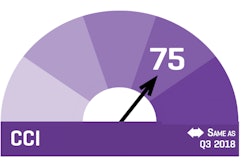
Triax Technologies, Inc., a leading provider of technology for the connected jobsite, shared its predictions for the key technology trends that will shape the construction industry in 2019, impacting contractors as well as their employees and industry partners.
“The construction industry has been making great strides in digitization, and we expect this to accelerate in 2019,” said Pete Schermerhorn, president and CEO, Triax Technologies. “Construction technology has moved past the early-adopter stage, and in the new year, IoT technology and analytics will become more firmly entrenched in construction processes across the project lifecycle. As more data is collected, and more resources are put in place to support it, IoT will become an integral part of daily operations and strategic decision-making.”
Below are the five technology trends that Triax expects to shape the construction industry in 2019:
- IoT will embed itself across the project lifecycle. 2018 was the year that practical IoT-based applications took hold at the jobsite, and in the new year, contractors will continue to make automatic data collection from resources on site (workers, equipment, tools, etc.) a priority. As existing IoT solutions add new types of sensors to enrich the types and quantity of data collected, organizations will expand their use of data for real-time monitoring and control. IoT will also become more embedded in existing construction processes throughout the jobsite, in areas such as site control and security, to achieve efficiency gains. The widespread adoption of IoT and the groundswell of data will drive greater adoption of visual data analytics tools and dashboards.
- Data will become king. The past year represented only the tip of the iceberg when it comes to achieving data-driven insights. While progress was made, there is still a long way to go. According to research, 90% of the world’s data was created in the past year, but only 1% is being used effectively. In 2019, construction firms will further invest in their internal data collection, analytics and decision-making processes (e.g. hiring data specialists, integrating new data sets into their own internal platforms) to act upon data insights in a timely and effective manner. This will advance industry digitization efforts, firmly moving technology from the hypothetical to the practical in the new year.
- Point-solution fatigue will spark further integration. In 2019, more contractors and technology providers will work together to build truly integrated systems. Customers do not want to use multiple platforms for similar functionality, and as they become more tech savvy, and more solutions become available, they will increasingly integrate third-party data sets with internal platforms and processes. On the provider side, Application Programming Interfaces (APIs) will become more sophisticated, as enterprise software players develop the functionality to incorporate new data sets and tech start-ups collect more data. This time next year, we expect there will be enhanced cooperation — and meaningful integration — among key technology players in the space.
- Tech will augment, not replace, workers. Despite advances in automation, buildings will continue to be built by humans for the foreseeable future. In 2019, the story will not be technology replacing the workforce but technology empowering the workforce to do their jobs better. Contractors will continue to search for solutions that are employee-friendly and unobtrusive, prioritizing features such as battery life, small form factor and worker privacy. With the skilled labor shortage showing no signs of slowing down, companies will turn to technology to do more with fewer resources and will continue to hire and train employees to incorporate technology into their work.
- Insurers will further embrace IoT. Construction technology has moved from a competitive advantage to an operational necessity. In 2019, a growing number of insurance organizations are expected to make IoT technology and data analytics a key part of their risk management and mitigation practices. As early technologies, such as wearable devices, improve injury response and hazard communication, more insurance organizations will embrace innovation to deliver value to their clients and prevent unnecessary losses. In 2019, we expect to see more direct investment and partnership between insurance carriers and tech providers.



















